
Still Booking on De Quincey’s Mail-Coach
Robin Jarvis looks at Thomas de Quincey's essay "The English Mail-Coach, or the Glory of Motion" and how its meditation on technology and society is just as relevant today as when first published in 1849.
February 20, 2013
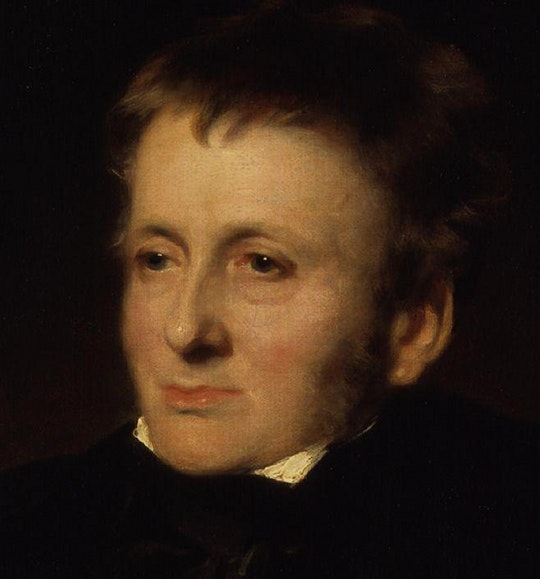 Scroll through the whole page to download all images before printing.
Scroll through the whole page to download all images before printing.Detail from a portrait Thomas de Quincey by Sir John Watson-Gordon, date unkown — Source.
In the last quarter of 1849 Thomas De Quincey published two separate essays in Blackwood’s Edinburgh Magazine, a leading Tory periodical. These two essays, entitled “The English Mail-Coach, or the Glory of Motion” and “The Vision of Sudden Death,” were revised and amalgamated five years later to produce one of the author’s most memorable and idiosyncratic pieces. “The English Mail-Coach” is at once a celebration of that form of transport and an elegy for its demise, since by the time De Quincey published his essay the railways had already spread across the country and shunted the mail-coach into the sidings of history. As an exercise in technology nostalgia, therefore, the essay might be compared to someone recalling fondly the brick-like mobile phones of the 1980s while necessarily using a modern, lightweight smartphone and perhaps grumbling at the way it increasingly dominates their waking life.
“The English Mail-Coach” is in four parts. In the first, De Quincey explains his fascination with mail-coaches and recalls his delight in using them — insisting always, against the grain of class preference, on an outside seat — to go to and from Oxford in his student days. He relates his obsession to the pleasures of unprecedented speed, with the thrill of “possible though indefinite danger”; the visual stimulation of “grand effects,” as deserted roads at night are momentarily lit up by coach-lamps; the sheer spectacle of “animal beauty and power”; the sense of participating in a great national system, akin to a living organism; and the additional excitement of bringing news, good or bad, from the battlefront (during the Napoleonic Wars) to local communities far and wide.
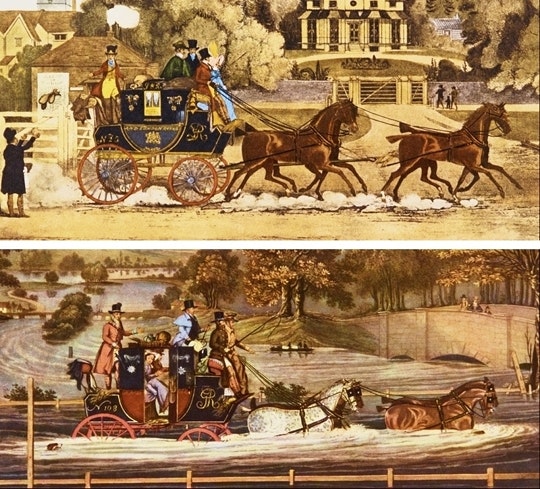 Scroll through the whole page to download all images before printing.
Scroll through the whole page to download all images before printing.Details from two paintings of mail-coaches by James Pollard — Source.
In the second section of the essay, “Going Down with Victory,” De Quincey elaborates on the adrenalin-fuelled experience of bearing tidings of war, kindling joy all along the route “like fire racing along a train of gunpowder,” and describes the more ambivalent experience of giving one woman a partial account of the “imperfect victory” at Talavera, a costly battle in which her son’s regiment has, he believes, been virtually wiped out. In the third section, “The Vision of Sudden Death,” he narrates an incident at night on the Manchester-to-Kendal mail in which the coachman nods off and, with De Quincey seemingly unable to seize the reins and take evasive action, the vehicle narrowly avoids collision with two lovers in an oncoming gig. It is only the young man in the gig who can avert disaster, and he responds with only seconds to spare. In the final section, the celebrated “Dream-Fugue,” De Quincey tells the reader how the figure of that same terrified young woman, glimpsed for just a few moments, subsequently entered into the “gorgeous mosaics” of his dreams, featuring in a variety of perilous or fatal situations. In the final, apocalyptic, dream-sequence De Quincey’s mail-coach becomes a “triumphal car” proceeding at supernatural pace down a cathedral aisle of infinite length; a female infant who temporarily obstructs its path somehow becomes synonymous with all the victims of war, past and present, while her apparent survival or exaltation stands not only for the material gains of “Waterloo and Recovered Christendom” but also for the spiritual end of resurrection and eternal life.
Even this brief summary should make clear that De Quincey’s mail-coach is more than just a horse-drawn carriage. It is, in fact, a powerful mobile metaphor, freighted with all manner of symbolic meanings that modern literary critics have delighted in picking over. Sometimes these meanings seem startling or contradictory. It is, for instance, remarkable that the mail-coach, which at the beginning of the essay epitomises pre-industrial travel and communications and is an object of sentimental regard, nevertheless somehow comes to represent the unstoppable flight of Britain into an industrialised modernity. The unnerving speed of the mail-coach expresses, for some readers, the velocity of social change or the urgency of historical process. For others, the vehicle embodies the hopes and fears of the nation at a critical stage in the European theatre of war, or reflects the author’s belief in Britain’s pre-eminence as an imperial power. For critics of a certain theoretical persuasion, the mail-coach has even been read as a metaphor for the power and unpredictability of language itself.
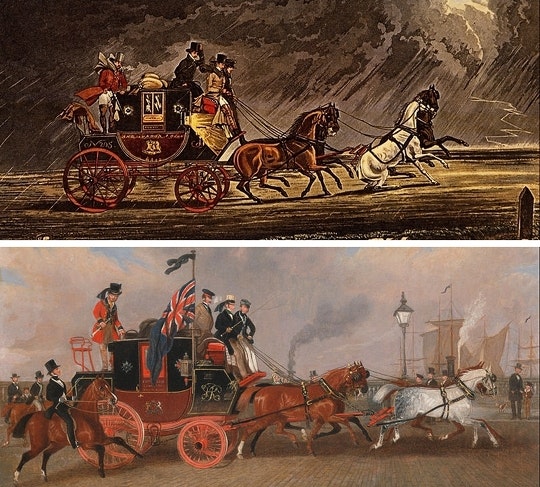 Scroll through the whole page to download all images before printing.
Scroll through the whole page to download all images before printing.Details from two paintings of mail-coaches by James Pollard, including, at the bottom, The Last of the Mail Coaches at Newcastle upon Tyne (1848) — Source.
The logic and relative strength of these various interpretations can, of course, only be assessed via a careful reading of the whole essay, and in that undertaking every reader’s journey is his or her own. In a similar manner, only by immersing oneself in De Quincey’s beautiful yet often convoluted prose can one properly appreciate the ingenuity with which a meditation on road travel, brought to life initially as an intense physical and sensory experience (“we heard our speed, we saw it, we felt it as a thrilling”), turns subtly yet completely into an account of movements of the mind and of humanity’s ultimate spiritual journey.
What is also fascinating for the modern reader of “The English Mail-Coach,” however, is the way in which, despite its almost antiquarian subject-matter, it continues to stimulate thought about aspects of modern society and culture. To take one example, speed is at the heart of De Quincey’s love affair with the mail-coach: he recalls fondly the “continually augmenting velocity of the mail” that sometimes seemed to “trample on humanity.” In fact, mail-coaches travelled, on average, at what must now seem an extremely sedate ten miles an hour, but in psychological terms there seems little to separate De Quincey’s experience from that of the first generation of railway travellers, who (as Wolfgang Schivelbusch pointed out in his classic study, The Railway Journey) celebrated the “annihilation of time and space” on the basis of locomotive speeds of 20-30 miles per hour. Then we think of the transport and communications technologies of our own time — of the serene efficiency with which planes can take us in a matter of hours to places our ancestors could only read or dream about, or of the almost indecent speed with which electronic messages can travel from one side of the world to the other. It seems that every generation is fated to rediscover the extinction of time and space in its own manner.
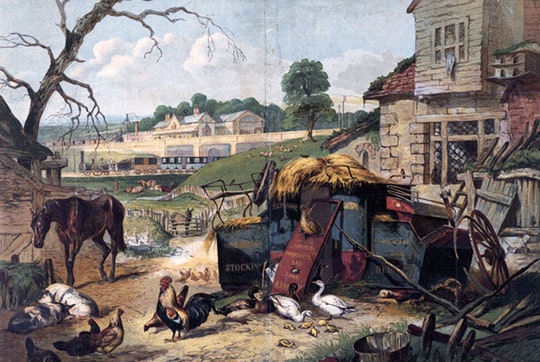 Scroll through the whole page to download all images before printing.
Scroll through the whole page to download all images before printing.Past and Present through Victoiran Eyes (1850), a Leighton Brothers print. Note in the distance, behind the abandoned mail-coach being used to house straw, the new train locomotive which came to replace it — Source.
One of the striking features of De Quincey’s retrospective account is the degree to which he relishes being the physical embodiment of good news, so that the typical response of citizens elated by confirmation of military success seems to have been to throw their arms around the mail-coach aficionado. This fits with his preference for the mail-coach over the railway as the central instrument of an organic, rather than mechanical, system. His choice of words in calling the mail-coach a “national organ” for broadcasting momentous news is no accident: he writes elsewhere of an ideal state of communication “between the centre and the extremities of a great people” as resembling “the systole and diastole of the human heart,” and for him it was the mail-coach, rather than the railways, that came closest to realising this biological model. This was because it relied more visibly on human energies and effort, transmitted by some mysterious contagion to the “electric sensibility of the horse,” rather than on the mechanical “interagencies” of “iron tubes and boilers” that had no sympathy with the affairs of men. What the close cooperation of man and beast seemed to guarantee was that there was no dilution of passion as news and opinion travelled around the network; ultimately, what De Quincey desired was that all communication should have the spontaneity and directness of a face-to-face encounter.
Curiously enough, the rapid development of digital technologies and new media has done nothing to disqualify De Quincey’s seemingly impossible dream. Despite the obvious financial benefits for companies and other organisations of cultivating virtual relationships, business travel has not diminished but in fact continues to grow year on year, with time-poor men and women criss-crossing the globe in order to look each other in the eye and seal agreement with a handshake. Neither have the new technologies turned their back on the ethos of personal encounter, as the one billion worldwide users of Facebook, with its instant messaging, voice calling, and video calling facilities can testify. It seems that every step forward in the digital era also takes us back, perversely, to De Quincey’s nostalgic pre-industrial world of human connections, of the constant befriending of total strangers, and the stubborn reliance on spontaneous word and gesture.
De Quincey’s musings on sudden death, prompted by recollections of his near-catastrophic collision with the young couple in a gig, also have a strange contemporary resonance. He begins by contrasting pagan and Christian attitudes to sudden death, which, he suggests, may depend on different meanings of the phrase: an “unlingering death” versus “a death without warning.” Then he focuses on one particular variety of sudden death, that in which the victim has “some hurried and inappreciable chance of evading it,” and must act speedily and decisively in what will, in all likelihood, be a forlorn attempt at survival. Even more desperate, De Quincey says, is a situation in which another life or lives depend on one’s acting with such rapid resolve. Here arises the spectre of moral cowardice, of a man in desperate straits lying down before the lion (in De Quincey’s idiosyncratic phrase): “The effort might have been without hope; but to have risen to the level of that effort—would have rescued him, though not from dying, yet from dying as a traitor to his duties.”
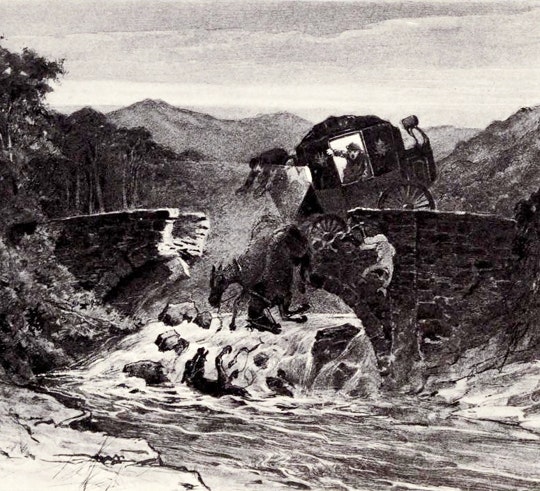 Scroll through the whole page to download all images before printing.
Scroll through the whole page to download all images before printing.“Mail-coach accident near Elvanfoot, Lanarkshire” from The Royal Mail, its Curiosities and Romance (1885) by James Wilson Hyde — Source.
“It is not,” De Quincey remarks, “that men generally are summoned to face such awful trials.” And yet, sometimes they are. On 11 September 2001, some passengers on United Airlines Flight 93 fought to regain control of the hijacked plane, one of four commercial airliners deployed in the coordinated al-Qaeda assault on the United States. Staring death in the face, and having already heard via in-flight calls of the attack on the World Trade Centre, they somehow forced the hijackers to abandon their target (most probably the US Capitol) and crash the plane in an empty field in rural Pennsylvania. All forty passengers and crew were killed, but the passenger revolt almost certainly prevented much greater loss of life on the ground. As with De Quincey’s young man, who has mere seconds to manoeuvre his carriage into a safer position and save the life of his female companion, “sudden had been the call upon [them], and sudden was [their] answer to the call.” The circumstances could hardly be more different, yet much of what De Quincey says about the courage required to face “some fearful crisis on the great deeps of life” seems to apply just as well, if not better, to Flight 93 as to his scary incident on the road to Preston.
As we now know, the story of Flight 93 also demonstrates the frightening power of modern communication technologies — which is, of course, the central theme of De Quincey’s essay. Using Airfones or their own mobile phones, many passengers were able to call their husbands, wives, or other family members, to inform them that they were almost certainly about to die, and to tell them one last time that they loved them. (By contrast, the hysterical young woman in the gig was able only to throw “up her arms wildly to heaven.”) How De Quincey might have contemplated the unspeakable anguish of such a call is difficult to imagine. This is surely one form of instantaneous — if not face to face — communication that he would have balked at.
It is the ability of De Quincey’s essay to trigger such unexpected yet thought-provoking connections that gives it its enduring appeal. Despite its historical subject-matter and its general orientation towards the past, the “English Mail-Coach” is still picking up new meanings and relevancies, is still an intense, sometimes uncomfortable, yet exhilarating ride.
Robin Jarvis is Professor of English Literature at the University of the West of England, Bristol. His many books and articles on Romantic literature include Romantic Writing and Pedestrian Travel (Macmillan, 1997), The Romantic Period: The Intellectual and Cultural Context of English Literature, 1789-1830 (Pearson, 2004), and Romantic Readers and Transatlantic Travel (Ashgate, 2012).







